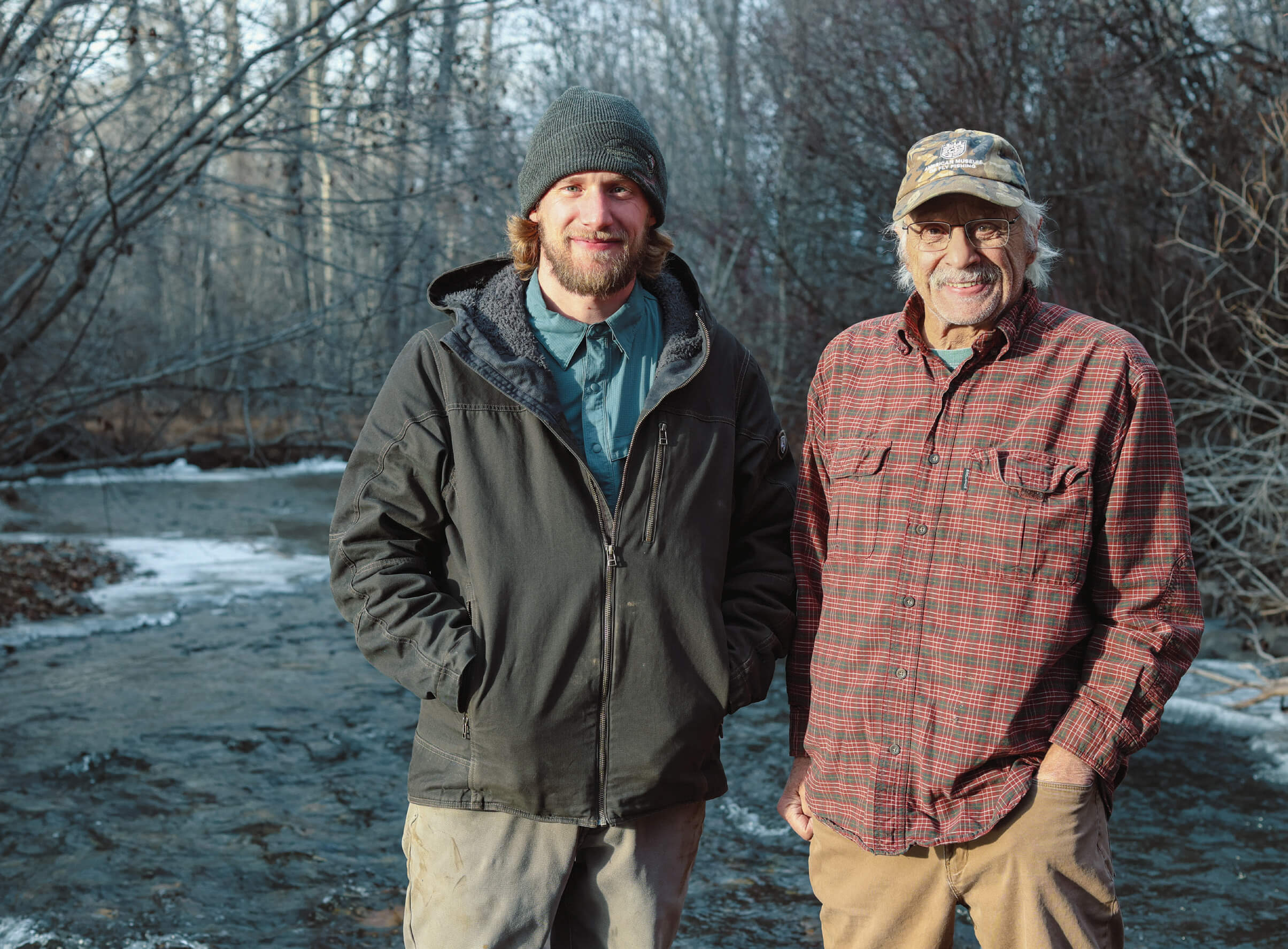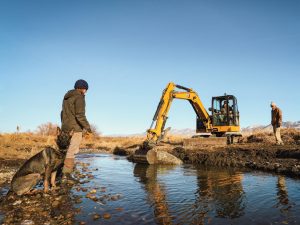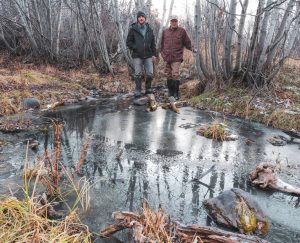
01 Feb Local Knowledge: Restoring Natural Environments
Water, no matter if it’s at the beach, running through a creek, or even in a puddle, is as fascinating to kids as it is to anglers. They’ll play in it all day long if you let them — splashing, digging holes, making channels. Joseph Urbani was no different as a child. The thing about Urbani, who is now 75, is that he never stopped: The Bozeman, Montana resident went on to become one of the country’s foremost freshwater fisheries biologists.
“I grew up on a farm in New Jersey, and we had a stream running through the back 40,” he recalls. “When I was little, I loved building rock dams and digging holes, watching how they changed the water and the water changed them, and the life they held. Later on, when I was around 10, I noticed there were catfish and suckers in the creek that would come up from the Delaware and Raritan Canal, and I was amazed by the interconnectedness of all these waterways.”

The Urbanis supervise the recent habilitation of a small waterway in Bozeman, Montana that will be part of a nature education reserve.
Fascinated with the natural world behind his house, Urbani became an avid angler and an amateur naturalist, exploring as much of the outdoors as New Jersey had to offer throughout his childhood and into his teens. And, while he was accepted to the prestigious Rutgers University, he knew he would have to go further afield to continue his exploration of Mother Nature and her rivers, especially considering the condition of the Garden State’s waterways. “At that point, the Raritan River and its tributaries were purple due to pollution,” Urbani says. “Instead, I decided to go to Colorado State University to study freshwater fisheries biology and learn to fly fish.”
Though he fell in love with the open spaces and wide rivers of the West, Urbani returned home each summer to work for New Jersey Fish & Game (now New Jersey Fish & Wildlife), initiating a career in environmental management that has spanned more than 40 years. Upon graduation, he made the move West permanent, accepting positions working for both Colorado’s and Montana’s fish and game departments (now Colorado Parks & Wildlife and Montana Fish, Wildlife & Parks, respectively), as well as a five-year stint with Alaska Department of Fish and Game.
By the late 1970s, he was working for the U.S. Forest Service at the supervisor’s office in Bozeman, enhancing stream habitat for waters like Hyalite, Grayling, and Pine creeks. When Ronald Reagan became president and cut funding for environmental field projects, Urbani was left with no choice but to enter the private sector. “It was either that or take a desk job, and I wanted to stay in the field,” he explains.
Collaborating with a group of scientists and engineers, Urbani became a founding partner in the aquatic consultant firm Inter-Fluve. In addition to turning gravel pits into some of the ponds seen around Bozeman today, he spent much of his time fixing streams that his predecessors had denaturalized through the use of rebar, wire, and culverts. “A lot of water-resource techniques cause problems by over-engineering solutions that don’t work because rivers are dynamic systems,” Urbani says. “The river tells you where it wants to go. It’s our job to read the river — its scour zones, which are pools, and depositional zones, which are riffles — to create natural solutions to issues like bank erosion, silt build-up, ill-advised dams, and fish and riparian habitat loss or degradation.”
This approach has made Urbani Fisheries an internationally known designer, builder, and restorer of aquatic habitats. Urbani’s clients include Ted Turner and Jimmy Carter — Urbani spent a week bio-sampling the former president’s fishery in Georgia. “He was a very nice guy, very down to earth,” Urbani recalls. “He even called my parents and wished them a happy anniversary.”
Apologies to U.S. president number 39, but probably the biggest stars that Urbani has worked with are Robert Redford and Brad Pitt. In 1991, right around the time he split from his partners and started Urbani Fisheries, Urbani heard from his friends Jim Belsky — a Sports Illustrated writer and Smith River advocate — and Bozeman resident and conservationist Joel Shouse, that Redford was scouting for locations for the film A River Runs Through It. Urbani joined the team, which included producer Patrick Markey, who moved to Montana during the shoot and never left.
“We were traveling around the state, and, as everyone knows, since the Blackfoot was in such bad shape, we all convinced Redford to shoot on the West Gallatin River,” Urbani says. “When they were filming, I was the production’s fish biologist, sourcing the trout for the film and making sure they were ready when it was their turn to be on camera.” His work was such a success that he went on to work with Redford and Markey again, building the pond featured in The Horse Whisperer.

Among the many creeks the Urbanis have rehabilitated in Montana is this one conveniently located on their Bozeman property, which ensures they are never far from water or good fishing.
While Urbani was growing his business in Bozeman, he was also growing a family with his wife, Sydne, a retired Bozeman school teacher. Their daughter, Lindsay, and three sons — Joey, Colter, and Dylan — all went through the local school system, worked at Urbani Fisheries, and were brought up with fishing rods in their hands. “I can’t remember a time when I wasn’t fishing with my dad and brothers,” says Colter, now age 34.
These memories also include a Coast Guard rescue when a storm hit during a fishing trip for redfish off Padre Island, Texas, and almost being swept away when high winds threatened their belly boats on Clark Canyon Reservoir. “Discovery Channel heard about the rescue in Texas and sent us all back down there to reenact the ordeal for the TV show ‘Storm Warning!’,” Colter reminisces. “Sometimes you can still see it on the Weather Channel.”
These near-death experiences didn’t sour Colter on fishing or the family business; he worked for his dad throughout high school. Still, when it came time to pick a career, he thought he would be a doctor, going so far as to intern for a surgeon. “I got a degree in cell biology from Montana State,” he says. “I love biology and studying the body and the brain, but I couldn’t handle being in the hospital — it was too stressful, and there’s too much death.” Sounding very much like his dad, he adds, “Plus, I needed to get outside.”
Around this time, Urbani’s company was seeing some turnover as employees left to start businesses or work for government organizations. Colter started to fill in, doing all the things he had learned growing up fishing and working with his dad. “I saw the work these people did for my dad and kept noticing how the techniques could be improved,” he says.
After giving Colter a chance to lead some projects, Urbani agreed. Now, Colter is his dad’s right-hand man as they travel the country restoring fish and wildlife habitats, though they continue to work in the Bozeman area, too, as they did when Dylan joined them to wrangle fish on the 2023 film Mending the Line.
Colter has become so accomplished in his own right that Urbani plans for him to take over the family business when he retires. “His knowledge in trout habitat restoration is unsurpassed, and he possesses a creative artistry and unequaled understanding of aquatic system design,” says Urbani about Colter. “He’s far ahead of the curve when it comes to utilizing new technology, and his ability to communicate with agencies and clients alike creates an atmosphere of understanding and confidence.”
For his part, even as he’s cutting his own path in the business, Colter says he still learns from his dad. “He has worked so many places and has so many stories, it’s like working with an encyclopedia,” Colter explains with a smile.
In fact, Urbani’s knowledge is so vast and unique that Colter is trying to persuade him to write a book. “There are some textbooks out there on aquatic restoration, but they are really academic or invasive,” Colter says. “I’d love to see my dad present his organic approach that’s much more practical and focuses on letting environments be natural and not wasting resources.”
Both father and son love the before-and-after aspect of their work. “By adding vegetation to enhance riparian zones, moving rocks, building spawning riffles, removing debris, excavating pools, and more, we produce a biological uplift to fish, wildlife, and aquatic invertebrates, giving these environments the ability to essentially heal themselves and proliferate,” Colter says. “As the landscape improves, so does the biodiversity, which includes aquatic invertebrates as well as the health of the fish populations.”
They know about the latter because one of the perks of the job is being able to wet a line in the waters they rehabilitate, though Urbani is quick to point out, “It’s not fishing, it’s sampling.”
It’s a safe bet that anywhere the Urbani family is working, the sampling is as good as it gets.
An avid fly fisherman based in Bozeman, Montana, Stephen Camelio is a former editor for InStyle magazine and has written for Fly Rod & Reel, The Drake, and Field & Stream, among others. He’s a regular contributor to Yellowstone Quarterly, and he wrote the fishing chapter for the guidebook Yellowstone in a Day. Recently, Camelio was awarded a Big Sky Film Grant for his original fly-fishing screenplay Mending the Line.
Melanie Maganias loves capturing the essence of her subject matter in editorial assignments, at weddings, and in portraits by following her intuition and using her camera as a tool to depict her vision. Named one of America’s Top 15 Wedding Photographers by PDN, her work has been featured in The New York Times, Forbes, Real Simple Weddings, Martha Stewart Weddings, and many other publications. She earned bachelor’s and master’s degrees in photography and has also taught at Montana State University.




Anita Petrucci Whaley
Posted at 16:59h, 12 FebruaryWhat an awesome recap of Joe & Colter’s work.They are talented enviromentalists.
Arthur Christen
Posted at 17:51h, 12 FebruaryGreat history of the Urbani Company. Very interesting. I have worked with Joe and his staff in the past and they are the best at restoring trout streams. They know exactly what needs to be done and I would recommend them to anyone. He and his company team have been doing stream restoration for a very long time and he has the expertise from successfully completing many, many projects.
Cindy Laner
Posted at 19:53h, 12 FebruaryBravo, Joe!
Robert Hutfles Hutfles Excavating
Posted at 22:15h, 13 FebruaryWhat some people do not realize is that Joe taught the majority of past and current pond and stream builders ” How to do it right”. I worked with him on many projects, 6 different states. Always learned so much from him. Without Joe’s expertise the water world that so many are enjoying today would be very lacking and not nearly as natural and productive.
William Young
Posted at 16:59h, 21 FebruaryAbsolutely wonderful story.